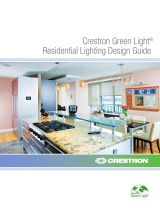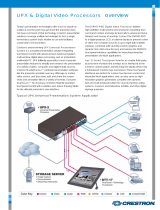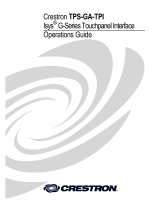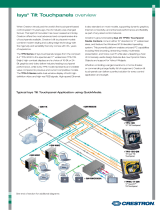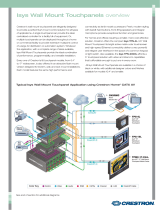
10.4 Inch Tilt Touchpanel Crestron Isys
®
TPS-4000
Calibration Menu
CALIBRATION MENU
Calibration of the touchscreen is required if the active touch area of a button does
not coincide with the button's image. Select the Touch Screen Calibration
utton to
dis
lay the CALIBRATION MENU, shown to the left. The CALIBRATION MENU
offers the choice to initiate calibration with the Perform Calibration button or
return to the previous screen with the Return button. Choose an option by touching
the correct button.
If you proceed to calibrate the touchpanel, the screen displays the message “Touch
Upper Left” centered on the panel with a cross hair in the upper left corner. Touch
the center of the cross hair in the corner of the screen to initiate calibration. Another
message, “Touch Upper Right”, appears with a cross hair in the correct corner.
Touch the center of the cross hair in the corner of the screen. A final message,
“Touch Lower Right”, appears with a cross hair in the correct corner. Touch the
center of the cross hair in the corner of the screen to conclude calibration and return
to the MAIN MENU.
NOTE: When touching the screen during calibration, be as accurate as possible.
Use the tip of a capped pen or the eraser end of a pencil. To cancel calibration and
return to the CALIBRATION MENU without saving calibration data, create a
calibration error by touching the screen in the same spot for each calibration point.
NOTE: The touchpanel’s calibration routine can also be accessed through the
Viewport Utility if the touchpanel is connected to a control system via Cresnet or to
a PC via RS-232 by selecting Functions | Put Touch Panel into Calibration
Mode… from the Viewport menu.
Setup Menu
SETUP MENU
To access the SETUP MENU, shown to the left, press the Setup button from the
MAIN MENU. The SETUP MENU offers a series of buttons, which opens
additional menus and displays, which are detailed in subsequent paragraphs. Setup
parameters (i.e., interface, audio, video, screen settings, RS-232, and timeout) use
additional menus and are detailed in subsequent paragraphs as well. After setup
parameters have been set, select the Return button to return to the MAIN MENU.
NOTE: The current CRESNET ID setting is displayed in the lower left corner of
the SETUP MENU.
NOTE: All touchpanel settings are automatically saved in non-volatile memory.
Interface Menu
INTERFACE MENU
The touchpanel communicates with a control system to activate commands or to
display feedback from components within the system. The communication interface
must be correctly specified or communication will not occur. To set communication
parameters select the Interface
utton located on the SETUP MENU and display the
INTERFACE MENU, shown to the left.
The Cresnet network identity number (CRESNET ID) is displayed on the
INTERFACE MENU. CRESNET ID is a two-digit hexadecimal number. The
hexadecimal number can range from 03 to FE and must correspond to the Net ID set
in the SIMPL Windows program of the Cresnet system. Matching IDs between the
touchpanel and SIMPL Windows program is required if data is to be successfully
10 • 10.4 Inch Tilt Touchpanel: Crestron Isys
®
TPS-4000 Operations Guide - DOC. 6268




















